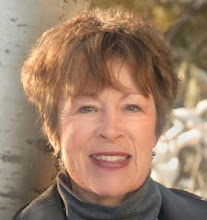From 1913 to 1916 Mabel Dodge opened her New York home at 23 Fifth Avenue to avant garde movers and shakers. In recognition of Mabel's ability to draw people out, writer Lincoln Steffens urged her to "have evenings." Mabel held her first salon in January 1913, which provided a forum for "radicals" of that period. A year later a New York reporter devoted a full page to "The Salon Dodge" where, according to the topic, an eminent Columbia University professor might speak on Freud and psychoanalysis, or an English scientist discuss eugenics, or feminist leaders argue for communal nurseries, birth control and higher education for women.
 | |
| Mabel Dodge, no date |
 |
| Tibetan monks with Judi Jordan at Juniper House |
This past July, eleven Buddhist monks and their driver from the Drepung Loseling Monastery in Dharamsala visited the Mabel Dodge Luhan House.These Tibetan monks have been coming to Taos since the 1990s. This is the third or fourth time the Mabel Dodge has hosted them.Years ago I attended a performance of Tibetan sacred music at the Juniper House (the Mabel Dodge's classroom/meditation hall/performance space). This year, however, the focus was different.
Although they spent most of their time at Juniper House, I first noticed the monks in the kitchen helping Chef Jane Garrett with lunch preparations. Maria Fortin caught them cutting up vegetables.
 |
One monk told me how the Mabel Dodge Luhan House staff made everyone feel at home. Their happy faces appear in so many of the photos Maria took of them, like the one with Karen Young in the dining room. (The monks honored Maria for her managing skills and kind assistance throughout their visit; you'll meet her soon.)
Karen directed me to Juniper House where the monks were constructing a sand mandala. I went to investigate. I found out that it takes years of training to construct mandalas. A young monk memorizes texts that define the basic structure of each design (there are numerous Tibetan mandalas, each representing specific enlightened beings), learns to draw a chalk pattern outlining it, and then masters the exact placement of the sand as well as how to control the pour of colored sand from the cornet onto the mandala's chalk pattern.
 |
| Placing colored sand using cornets (inside Juniper House) |
During their visit the Dalai Lama celebrated his 75th birthday. The monks honored him with sacred chanting and music.
 |
| Honoring the Dalai Lama on his birthday (Juniper House) |
In seven days, the monks completed the mandala. On Saturday afternoon, the time came to dismantle it.
Prior to the closing ceremony, Geshe Lobsang Tenzin Negi, spiritual director of the Drepung Loseling Institute in Atlanta, explained that the mandala -- here a beautiful sand painting -- is more than a work of art. It represents the healing Amiya Buddha, and throughout the week the monks became that being, represented that being, and offered prayers for healing, supplications for blessings and peace for the community and for the world. The dismantling of the mandala represents impermanence, a symbolic reminder of change. In a traditional ceremonial manner, the sand is swept into swirls until the pattern dissolves and leaves a mound of color.
Along with several other observers, I received one of the small bags of sand from the monks to use for healing. The monks gathered the other half into an urn, drove to a nearby river, and poured the sand into the water. The river will carry the sand to bless the ocean...and the blessings will someday fall as rain.
I think Mabel would have liked that.
Adios for now,
Liz
NEXT: Mabel and the defense of native rights, the 40th anniversary of the return of Blue Lake to Taos Pueblo
Mabel Dodge photo courtesy of the Beineke Library, Yale University
All other photos by Maria Fortin, Mabel Dodge Luhan House




love coming to this site. you're articles are a treat. sas's workshop began the day after the un-sanding ceremony...and the studio was so fresh and full of blissful energy...the sound of that saturday was resonating.
ReplyDeletei just finished TAOS TRUTH GAME, with mention of Spud and so many others woven into this great little book around Mabel's circle...thanks for the touchstone here.
Thank you for the article and the pictures of the monks. I was visiting Taos and had the opportunity to see them. This was such a wonderful reminder of that extraordinary experinece.
ReplyDelete